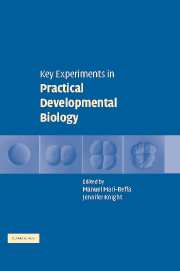Book contents
- Frontmatter
- Contents
- List of contributors
- Preface
- Introduction
- SECTION I GRAFTINGS
- SECTION II SPECIFIC CHEMICAL REAGENTS
- 4 Chemotaxis of aggregating Dictyostelium cells
- 5 Inhibition of signal transduction pathways prevents head regeneration in hydra
- 6 Retinoic acid during limb regeneration
- SECTION III BEAD IMPLANTATION
- SECTION IV NUCLEIC ACID INJECTIONS
- SECTION V GENETIC ANALYSIS
- SECTION VI CLONAL ANALYSIS
- SECTION VII IN SITU HYBRIDIZATION
- SECTION VIII TRANSGENIC ORGANISMS
- SECTION IX VERTEBRATE CLONING
- SECTION X CELL CULTURE
- SECTION XI EVO–DEVO STUDIES
- SECTION XII COMPUTATIONAL MODELLING
- Appendix 1 Abbreviations
- Appendix 2 Suppliers
- Index
- Plate Section
- References
6 - Retinoic acid during limb regeneration
Published online by Cambridge University Press: 11 August 2009
- Frontmatter
- Contents
- List of contributors
- Preface
- Introduction
- SECTION I GRAFTINGS
- SECTION II SPECIFIC CHEMICAL REAGENTS
- 4 Chemotaxis of aggregating Dictyostelium cells
- 5 Inhibition of signal transduction pathways prevents head regeneration in hydra
- 6 Retinoic acid during limb regeneration
- SECTION III BEAD IMPLANTATION
- SECTION IV NUCLEIC ACID INJECTIONS
- SECTION V GENETIC ANALYSIS
- SECTION VI CLONAL ANALYSIS
- SECTION VII IN SITU HYBRIDIZATION
- SECTION VIII TRANSGENIC ORGANISMS
- SECTION IX VERTEBRATE CLONING
- SECTION X CELL CULTURE
- SECTION XI EVO–DEVO STUDIES
- SECTION XII COMPUTATIONAL MODELLING
- Appendix 1 Abbreviations
- Appendix 2 Suppliers
- Index
- Plate Section
- References
Summary
OBJECTIVE OF THE EXPERIMENT The objective of the experiment is to demonstrate the existence of the phenomenon known as positional information. Within an organ such as the regenerating limb, the administration of retinoic acid (RA) at different doses can change this property and induce the regeneration of extra limb segments. This experiment is an excellent introduction to this basic principle in developmental biology.
DEGREE OF DIFFICULTY Easy. The experiment requires the limbs of anaesthetised axolotl larvae to be amputated with a razor blade or scissors at different levels, followed by the application of a powder to the water in which they live. After 4 weeks the regenerated limbs are stained as whole mounts for cartilage to reveal the regenerated structures.
INTRODUCTION
Urodeles (tailed amphibians) have the remarkable ability to regenerate their limbs throughout life, even as adults. Wherever a limb is amputated, the precise parts that were removed are replaced by a series of well-described processes. Firstly, the wound rapidly heals over by epithelial migration and a thickened epithelial cap appears over the stump (Figure 6.1a). Secondly, the cells of the tissues at the amputation plane (muscle, cartilage, nerve and connective tissue) dedifferentiate and return to a single-celled, embryonic state (Figure 6.1b). Thirdly, these dedifferentiated cells begin to proliferate and together form a conical structure at the tip of the stump, called a blastema (Figure 6.1c). Fourthly, as the blastema elongates, the structures of the limb that were amputated begin to redifferentiate in a proximal to distal direction.
- Type
- Chapter
- Information
- Key Experiments in Practical Developmental Biology , pp. 77 - 84Publisher: Cambridge University PressPrint publication year: 2005

